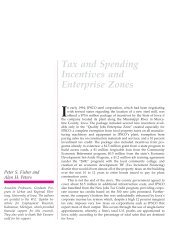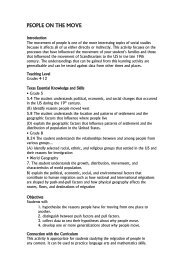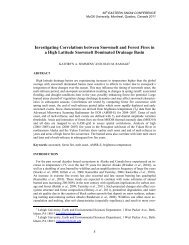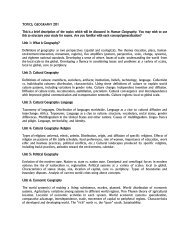Texas Social Studies Framework - Department of Geography ...
Texas Social Studies Framework - Department of Geography ...
Texas Social Studies Framework - Department of Geography ...
Create successful ePaper yourself
Turn your PDF publications into a flip-book with our unique Google optimized e-Paper software.
8<br />
§74.2 and §74.3(a) require school districts to “ensure<br />
that sufficient time is provided for teachers to teach<br />
and for students to learn...social studies...” and<br />
further allows school districts to “provide instruction<br />
in a variety <strong>of</strong> arrangements and settings, including<br />
mixed-age programs designed to permit flexible<br />
learning arrangements for developmentally appropriate<br />
instruction for all student populations to support<br />
student achievement <strong>of</strong> course and grade level<br />
standards.”<br />
§74.3 (b)(2)(D) and (E) require school districts to<br />
“<strong>of</strong>fer the following courses...and maintain evidence<br />
that students have the opportunity to take these<br />
courses: United States History <strong>Studies</strong> Since<br />
Reconstruction, World History <strong>Studies</strong>, United States<br />
Government, World <strong>Geography</strong> <strong>Studies</strong>, and economics<br />
with emphasis on the free enterprise system<br />
and its benefits.”<br />
HISTORY OF THE TEKS<br />
Chapter 2: An Overview <strong>of</strong> the <strong>Texas</strong> Essential Knowledge and Skills (TEKS) for <strong>Social</strong> <strong>Studies</strong><br />
The TEKS for <strong>Social</strong> <strong>Studies</strong> were adopted by the State<br />
Board <strong>of</strong> Education in July 1997. The process to develop<br />
the TEKS for all areas <strong>of</strong> the curriculum began with a<br />
decision by the board in 1994 to clarify the existing<br />
curriculum, called the essential elements, as a first step in<br />
aligning the state assessment program with the state<br />
curriculum. With the passage <strong>of</strong> Senate Bill 1 in June<br />
1995, the <strong>Texas</strong> Legislature modified the task by directing<br />
the board to identify “essential knowledge and<br />
skills . . . that all students should be able to demonstrate.”<br />
To do so, the board approved a process for developing<br />
the TEKS that ultimately included the appointment <strong>of</strong><br />
writing teams; a connections team to promote interdisciplinary<br />
connections; State Board <strong>of</strong> Education Review<br />
Committees; wide review <strong>of</strong> drafts by the field, the<br />
general public, and nationally known content experts;<br />
and regular board discussion and work sessions. Writing<br />
teams were charged with focusing on rigorous and<br />
measurable academic skills. The social studies writing<br />
team was made up thirty-five people, including teachers,<br />
curriculum specialists, university pr<strong>of</strong>essors, business<br />
people, and parents. The State Board <strong>of</strong> Education<br />
Review Committee for <strong>Social</strong> <strong>Studies</strong> was composed <strong>of</strong><br />
fifteen individuals charged with reporting their analyses<br />
<strong>of</strong> the draft TEKS for <strong>Social</strong> <strong>Studies</strong> directly to specific<br />
members <strong>of</strong> the board.<br />
Two drafts <strong>of</strong> the TEKS for <strong>Social</strong> <strong>Studies</strong> were widely<br />
distributed for field and public review. The process<br />
included distribution <strong>of</strong> the TEKS to districts and<br />
placement on the Internet, public hearings in every<br />
education service center region, and summary documents<br />
in both English and Spanish. The <strong>Texas</strong> Education<br />
Agency received approximately two thousand responses<br />
to the two social studies drafts, all <strong>of</strong> which were<br />
considered as members prepared their final draft for<br />
submission to the Commissioner <strong>of</strong> Education in December<br />
1996. Designated experts then reviewed the TEKS<br />
for accuracy, comprehensiveness, rigor, and other factors,<br />
leading to further revisions.<br />
In March 1997 the board held a work session on the<br />
TEKS for <strong>Social</strong> <strong>Studies</strong>, followed by public hearings in<br />
May and July, from which came additional changes.<br />
Final adoption came on July 11, 1997, with full implementation<br />
<strong>of</strong> the TEKS required in September 1998.<br />
Figure 1 provides a summary <strong>of</strong> the content <strong>of</strong> the TEKS<br />
for <strong>Social</strong> <strong>Studies</strong>.<br />
In 1996, the <strong>Texas</strong> Education Agency funded the <strong>Social</strong><br />
<strong>Studies</strong> Center for Educator Development (SSCED) to<br />
aid in implementation <strong>of</strong> the TEKS. The SSCED’s<br />
mission is to support a statewide system <strong>of</strong> ongoing<br />
education and pr<strong>of</strong>essional development in social studies<br />
for educators at all grade levels. Since its inception the<br />
SSCED has provided training in exemplary social studies<br />
content and methodology for trainers from the twenty<br />
education service centers. In addition the SSCED has<br />
developed and distributed a number <strong>of</strong> products that<br />
guide and enrich instruction in the TEKS. The SSCED<br />
website is accessible at .<br />
ORGANIZATION OF THE TEKS<br />
Organization across Grade Levels and Courses<br />
From Kindergarten through Grade 12, the TEKS for<br />
<strong>Social</strong> <strong>Studies</strong> are organized around eight strands:<br />
history; geography; economics; government; citizenship;<br />
culture; science, technology, and society; and social<br />
studies skills. Each strand is an integral part <strong>of</strong> a complete<br />
and comprehensive K-12 social studies curriculum,<br />
with none being considered more or less important than<br />
any <strong>of</strong> the others. While one strand may serve as the<br />
logical hub around which curriculum, instruction, and<br />
assessment are designed for a given grade level or course<br />
(the history strand as the hub at Grade 7 and 8, for<br />
example, or the government strand as the hub for the<br />
high school U.S. Government course), curriculum<br />
development would be incomplete without careful<br />
inclusion <strong>of</strong> all strands.
















